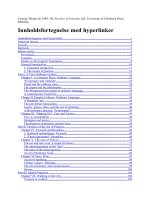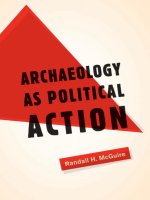university of texas press espíritu santo de zúñiga a frontier mission in south texas apr 2007
Bạn đang xem bản rút gọn của tài liệu. Xem và tải ngay bản đầy đủ của tài liệu tại đây (7.71 MB, 240 trang )
espíritu santo de zúñiga
Texas Archaeology and Ethnohistory Series
Thomas R. Hester, Editor
Espíritu Santo de Zúñiga
a frontier mission
in south texas
Tamra Lynn Walter
Foreword by Thomas R. Hester
university of texas press
Austin
Copyright © 2007 by the University of Texas Press
All rights reserved
Printed in the United States of America
First edition, 2007
Requests for permission to reproduce material from this work
should be sent to:
Permissions
University of Texas Press
P.O. Box 7819
Austin, TX 78713–7819
www.utexas.edu/utpress/about/bpermission.html
The paper used in this book meets the minimum requirements of
ansi/niso z39.48–1992 (r1997) (Permanence of Paper).
library of congress cataloging-in-publication data
Walter, Tamra Lynn.
Espíritu Santo de Zúñiga:afrontiermission in South Texas /
Tamra Lynn Walter. — 1st ed.
p. cm. — (Texas archaeology and ethnohistory series)
Includes bibliographical references and index.
isbn-13: 978-0-292-71478-6 (cloth : alk. paper)
isbn-10: 0-292-71478-5 (cloth : alk. paper)
1. Espíritu Santo de Zúñiga Site (Tex.) 2. Frontier and pioneer life—
Texas—Mission Valley Region. 3. Spaniards—Texas—Mission Valley
Region—Antiquities. 4. Indians of North America—Texas—
Mission Valley Region—Antiquities. 5. Spanish mission buildings—
Texas—Mission Valley Region. 6. Material culture—Texas—Mission
Valley Region—History. 7. Food habits—Texas—Mission Valley
Region—History. 8. Mission Valley Region (Tex.)—Antiquities.
9. Mission Valley Region (Tex.)—History. 10. Guadalupe River
Region (Tex.)—Antiquities. I. Title.
f394.e86w35 2007
976.4'492—dc22 2006032050
ForDonandmygrandmotherNellie
THIS PAGE INTENTIONALLY LEFT BLANK
CONTENTS
Foreword ix
Acknowledgments xiii
one
Introduction 1
two The Historical Record 7
three
The Archaeological Record 27
four Mission Architecture 48
five Investigations at Related Sites 74
six Mission Material Culture 84
seven Mission Foodways: The Faunal Collection 162
eight
Conclusions 187
Bibliography 199
Index 211
THIS PAGE INTENTIONALLY LEFT BLANK
FOREWORD
Having been trained as a prehistoric archaeologist, I had
never had much interest in the archaeology of the Spanish missions—even
though I spent a month in summer 1966 as a crew member on the first team
to conduct archaeology at the Alamo. However, in the 1970s and 1980s,while
teaching at the University of Texas at San Antonio, I gained a great deal of
exposure to Spanish colonial archaeology through projects by the Center for
Archaeological Research and largely through the efforts of Anne A. Fox and
Jack D. Eaton. This gave rise to a continuing interest in the material culture
of the Native Americans of the missions, and how data on that culture might
be used to evaluate their transition into Spanish life. Most of the time, our
excavation projects were very specific and limited exploration to test pits.
While we were able, for example, to trench the front wall of the Alamo right
next to its main entrance and to do test excavations at Espada to locate its
bastion, we had no opportunity to look at a broader view of mission layout.
However, in 1976–1977, Eaton, Fox, and I, along with Fred Valdez Jr. and
R. E. W. Adams (who had procured the grants), carried out excavations at
Missions San Bernardo and San Juan Bautista at Guerrero, Coahuila, Mexico.
These were the Gateway missions that Robert Weddle covered so extensively
in his book San Juan Bautista: Gateway to Spanish Texas, published by the Uni-
versity of Texas Press in 1968. Though we had specific goals in our research
program at the Gateway missions, most of these centered on the lives and
activities of the Indian groups who lived at these missions, as reflected in ar-
chitecture. But to understand the context of the Mission Indian occupations
we needed to know a great deal more about the layout of the missions, as
plans of these complexes never surfaced in the Spanish Colonial archives.
We were able to locate and identify many buildings and assess building
functions at both missions. This was made possible through judicious testing
and through Jack Eaton’s unnerving accuracy in predicting where the cor-
ners of buildings (and rooms within them) would be found! Unfortunately,
x Espíritu Santo de Zún˜iga
the broad array of structures linked to both these missions was obliterated
or at least heavily damaged after our fieldwork—by a root-plowing rancher
on private property adjacent to San Bernardo and, at San Juan Bautista, by a
Pemex worker seeking ‘‘treasure’’ with a bulldozer.
I knew little about the Espíritu Santo missions other than what I obtained
in visiting the state park in Goliad where the final location of the mission,
established in 1749, had been heavily restored. Espíritu Santo started out
in 1722 somewhere on Matagorda Bay, and has been the object of several
searches. Clergy at that first location tried to proselytize the Karankawa,who
were definitely not interested in the Spanish or their religion. The priests
heard of less hostile Indian groups on the Guadalupe River and in 1725 began
the transfer of Espíritu Santo to that more pleasant environment. An in-
terim second location of the mission may have been briefly established in
what is now the City Park of Victoria, Texas. In the early 1960s an amateur
historian inVictoria exposed some of the ruins known asTonkawa Bank. But
the definitive work was carried out in 1997 and 1998 by V. Kay Hindes, with
the important assistance of Kathleen Gilmore. There remains some debate
as to whether Tonkawa Bank is the second location of Espíritu Santo or an
outpost, a visita, linked to another location of Espíritu Santo (likely its third)
about five to six miles north of Victoria on the west side of the Guadalupe
River. A presidiowas established downstream on the east side that was briefly
studied by the Texas Archeological Field School in June 1968. Whether it
was the mission’s second or the third location, Espíritu Santo at this site on
the Guadalupe was a substantial undertaking, and records indicate that it
remained there from 1726 to 1749.
After the site was abandoned, the mission was covered by brush and first
recorded scientifically by C. A. Calhoun in 1965. The mission ruins were by
then on private property, and access to them was denied by a series of land-
owners for many years. Since the mission was in brush near the riverbank and
could be easily accessed by boat, the main portion of the mission complex
had been looted, bulldozed, and otherwise disturbed for decades. Indeed,
it was only through the continued efforts, starting around 1975, of E. H.
(Smitty) Schmedlin and Bill Birmingham, avocational archaeologists from
Victoria, that researchers visited the mission from time to time. In 1989 a
landowner cleared the brush from the ruins, and Smitty and Bill were per-
mitted to photograph the area, collect materials, and make a site sketch. But
when John and Judy Clegg bought the property, new opportunities arose.
Smitty arranged for the Texas Historical Commission to do limited testing
near the remaining standing ruins in spring 1995. And since Michael Collins
Foreword xi
and I were slated to teach a UT-Austin field school at a prehistoric site in
Victoria the coming summer, Smitty and Bill put on a full-court press for at
least a little attention to be directed to Espíritu Santo.
Tamra Walter, the author of this volume, contacted me in early 1995 when
she was a graduate student at the University of Montana. She was looking for
a possible master’s thesis involving a Spanish mission. It is always great when
a plan comes together! So, in 1995 I supervised TamraWalterandseveral other
field-school students in doing some test excavations at Espíritu Santo. For
my part, I never expected much more than a good sample of mission Indian
material culture to be used as comparative data with other missions in Texas
and northeastern Mexico. Fortunately, Walter developed an attachment to
the site that has led to many important new discoveries since. She went on
to do her master’s thesis (published in 1997) on the site, based on the summer
1995 investigations and some follow-up fieldwork. And there was no doubt
that her Ph.D. research would be expanded to furtherexplore Espíritu Santo.
Much of what Dr. Walter presents in this book stems from field schools
held at Espíritu Santo by the Texas Archeological Society in June 1997 and
June 1998. I served as project director, though all the hard work was done
by Walter and her graduate student colleagues (and collaborators like Anne
Fox and Jack Eaton)—and the hundreds of TAS members (454 in 1997) who
did such skilled excavation. It could have been chaos, but the TAS is well
organized, and manyof its top fieldworkers served as excavation supervisors.
With a workforce of that size and level of enthusiasm, many areas of the site
and associated locales were investigated. During this period, as Tamra’s book
details, the quarry for the mission was found and studied, a dam and acequia
system was rediscovered and mapped, and remnants of a more ambitious
dam upstream on the Guadalupe were found. The sharp eyes of an equip-
ment operator doing landscaping for the Cleggs led to the discovery of a
large,well-formed lime kiln, fullyexcavated in1997–1998. And excavation at
a ‘‘prehistoric’’ site just south of the mission indicated that many of the neo-
phytes may have lived at that spot, given the amount of eighteenth-century
Indian and Spanish material culture found there.We have at these sites a local
record of Native American continuity from Late Prehistoric times right into
the Mission era.
The abundant data presented in this book offer the first detailed view
into a mission that was a poorly known establishment whose location was
often in dispute, and that played a major role on the coastal plain of what is
now Texas in the early and middle eighteenth century. The mission at this
site provided the foundation for the establishment of the final setting of Es-
xii Espíritu Santo de Zún˜iga
píritu Santo, in Goliad, by involving the Aranama and Tamique Indians in
the mission process and starting the cattle herds that greatly expanded after
the move to Goliad.
From the work at the second location of Espíritu Santo on the Guada-
lupe River in Victoria County, Dr. Walter has obtained a more detailed,
scientifically based picture of the overall mission complex and its inner
workings. It is one of just a few missions that can be viewed in a broad
perspective. Most Texas missions are heavily restored (much of this occur-
ring in the federal Work Projects Administration programs of the 1930s),
even resplendent, and they are major tourist attractions. But those WPA
programs, sometimes supervised by architects and ‘‘cleared’’ with minimal
scientific recording, resulted in reconstructions often verging on the imagi-
native. The ruins of Espíritu Santo, by contrast, remain buried and covered
by brush, and evidence of the many endeavors that took place there is spread
broadly across the landscape.The mission has been restored only in the pages
of this book.
Thomas R. Hester
ACKNOWLEDGMENTS
As a graduate student at the University of Texas at Austin
I had the privilege of working at the site of Espíritu Santo for my disser-
tation research. Under the direction of Dr. Thomas Hester, a University of
Texas field school and two Texas Archeological Society (TAS) field schools
were conducted at the mission. These archaeological excavations formed the
basis of my research.
I would like to thank John and Judy Clegg for permitting us to work at the
mission and for their enthusiasm for the project. Smitty Schmieldin, Bill Bir-
mingham, Cecil Calhoun, and the countless volunteers and TAS field school
participants whoworked at the sitewere invaluable to the completion of this
project. Also I am indebted to Thomas Hester, who made all of this possible
and has provided guidance and support throughout the years. Jack Eaton,
Anne Fox, Kay Hindes, the ‘‘Mission Belles’’ (Betty Inman, Marilyn Shoberg,
Jane Lakeman, and Patsy Goebel), Dale Hudler, Brad Jones, Greg Ketteman,
Kinley Coyan, and Don Badon contributed both time and expertise to the
project since it began in 1995. Paul Edward De La Rosa provided several of
the illustrations, and Milton Bell photographed the artifacts. Harry Shafer
also provided much-needed guidance and constructive criticism of the ini-
tial manuscript. Funding was provided by the Texas Historical Foundation
and theTAS Donor’s Fund for the work completed at the mission in 1995 and
1996. Additional funding was provided by the Summerlee Foundation and
a Bromley F. Cooper endowed fellowship. The Texas Archeological Society
supported both the 1997 and 1998 field schools, and the Southern Texas Ar-
chaeological Association was very generous in providing local support for
the excavations.
THIS PAGE INTENTIONALLY LEFT BLANK
espíritu santo de zúñiga
THIS PAGE INTENTIONALLY LEFT BLANK
One INTRODUCTION
The Spanish Colonial era in Texas began in the sixteenth
century with the arrival of explorers such as Álvarez de Piñeda and Cabeza
de Vaca. The period lasted into the early nineteenth century and is marked
by the remains of missions, presidios, ranchos, visitas (visiting or outlying
missions), and various Spanish settlements. The region we now call Texas
includes a much greater area than the Hispanic Texas known to the Span-
ish as Tejas or the New Kingdom of the Philippines, as it was called from
1694 to 1715. During the Spanish occupation of the region, the area encom-
passed the lands to the north of the Medina River and east of its headwaters
into Louisiana (Chipman 1992, 1). Although Texas lacked the rich mineral
resources found in northern Mexico, it was nonetheless an important prov-
ince for the Kingdom of New Spain. Foreign intrusions into Spanish ter-
ritory from other European groups, especially those from French colonies
in the New World, were a constant threat to Spain’s landholdings and natu-
ral resources. The province of Tejas served as an important buffer zone be-
tween the northern boundaries of New Spain and the rich silver mines of
Mexico (Bolton 1915, Céliz 1935). In theory, Spanish officials hoped to colo-
nize the frontier of New Spain through conversion. Once Christianized,
the native groups would eventually be converted into loyal Spanish citizens
through the mission system. Ideally, these faithful neophytes would then
help protect the land and resources of New Spain from foreign incursions
(Bolton 1960).
The missionary efforts inTexas,carried out by the Franciscan order, there-
fore played an integral part in the attempts to colonize the region. From the
viewpoint of the government, the work of the missionaries was not only
to Christianize but also to civilize the lands north of Mexico and to work
toward holding and expanding this frontier (Bolton 1915, 10). Hence, much
time and effort were devoted to establishing missions among the various in-
2 Espíritu Santo de Zún˜iga
digenous groups of Texas. At least five missions were established in South
Texas alone for the Indian groups of the area. The Spanish Colonial mis-
sion of Espíritu Santo in present-day Mission Valley serves as an excellent
example of a Franciscan mission complex.
Although research has been conducted at many of the missions estab-
lished in various parts of the state, the missions in SouthTexas remain poorly
understood. In many cases archival information is sparse or nonexistent. For
example, available historical records documenting the mission’s third loca-
tion, the focus of our investigations, are limited to brief mentions of the
site, usually in relation to the nearby fort known as Presidio Nuestra Señora
de Loreto de la Bahía. To date, no descriptions of the mission’s layout or
architecture have been recovered from the archival records, much less in-
formation on daily events and lifeways of the mission inhabitants. The ar-
chaeological investigations of recent years have begun to bring these pictures
into focus, rendering material clues to who resided at the mission, what their
work entailed, and how they sustained themselves. Recent investigations at
the Espíritu Santo site in Mission Valley, therefore, provide an opportunity
to examine the mission system in a more detailed manner.
Both history and historical archaeology enrich our understandings of the
past; however, the two disciplines often ask very different questions. Histo-
rians may focus on prominent individuals in the past or on unique historical
events, while historical archaeologists trained in the field of anthropology,
for example, seek to reconstruct the everyday lives of both the renowned
and the anonymous. Each discipline can clearly supplement the other, yet
historical and archaeological data are not always equally accessible. In the
case of Mission Espíritu Santo, the archaeological record is obviously more
extensive than the few brief historical records that document the mission’s
third site near the Guadalupe River in what is now called Mission Valley.
Our investigations centered on this third location among the four sites Mis-
sion Espíritu Santo occupied during its more than one hundred years. Here,
archaeology must serve not only to answer anthropologically oriented ques-
tions (e.g., questions concerning daily life, subsistence economies, ethnicity),
but it also can serve to flesh out the historical record. The archaeology of
Espíritu Santo thus greatly enhances our understanding of this eighteenth-
century Spanish Colonial mission.
As a graduate student at the University of Montana and later at the Uni-
versity of Texas, I had the good fortune of meeting and working with
Thomas R. Hester, then a professor of anthropology at UT. Dr. Hester had
become interested in investigating an old Spanish mission in South Texas and
Introduction 3
suggested that I conduct excavations there for my master’s thesis. I quickly
accepted his offer. I eventually entered the doctoral program at UT and con-
tinued my research at Espíritu Santo in conjunction with fellow graduate
students and two Texas Archeological Society field schools.
The first formal investigations at Mission Espíritu Santo in MissionValley
began in the summer of 1995 and continued until the spring of 1999. A his-
torical marker was erected at the site in 1936 to commemorate the mission,
although no formal research had been conducted to verify that this location
was indeed the third site of Mission Espíritu Santo. Between 1936 and 1995,
occasional investigations were carried out at the site. Limited archaeological
testing and surface collections constitute most of the work that was com-
pleted there prior to the 1995 excavations. In 1965 a treasure hunter discov-
ered a burial within the mission ruins, and Cecil Calhoun, a local avocational
archaeologist, recorded it. The burial proved to be from the late nineteenth
century, and thus it was not associated with the Spanish Colonial occupation
of the mission (Calhoun 1965). Archeologists did not return to the site until
1975, when E. H. Schmiedlin, A. Fox, and C. K. Chandler completed a non-
random survey and surface collection of artifacts. The crew noted evidence
of extensive looting and disturbance by pot hunters inside the mission ruins.
In 1989 Schmiedlin, a steward for the Office of the State Archeologist (OSA),
reexamined the site and drew several preliminary sketches of the mission
layout. Schmiedlin produced a report on his investigations that brought the
site to the attention of the OSA.
In the spring of 1995 the OSA conducted limited excavations at the site to
assess its potential for future research. Encouraged by the findings, the OSA
recommended further research. That summer Dr. Hester directed archaeo-
logical investigations during the 1995 UT field school, and I participated
as part of my thesis research. Students and local avocationalists completed
test excavations at the site during the summer, and more testing followed in
the fall. UT students and the TAS continued excavations there until the fall
of 1999.
Considering the limited nature of the historical record, the archaeological
record serves as the main source of information for Mission Espíritu Santo.
Accordingly, excavations were oriented toward answering specific questions
that the written records alone did not address. My goals in presenting this
research are: first, to give an overall picture of the mission layout and its re-
lated sites; second, to provide a description of the history and everyday life
at Espíritu Santo; and finally, to exemplify the importance of archaeology
to both the history and ethnography of eighteenth-century Spanish Texas.
4 Espíritu Santo de Zún˜iga
Ideally, the study of Mission Espíritu Santo will serve as a model for research
at similar early Colonial sites in Texas and elsewhere.
In the following chapters I will present archival, archaeological, and ar-
chitectural data relating to the site as a way to bring the mission experience
to life. Chapter 2 presents a historical overview of Spain in the New World
and of Spanish Texas as context for the founding of Espíritu Santo. The his-
tory of the mission is discussed in its entirety, from its establishment on the
coast to its virtual abandonment in the late eighteenth century and even-
tual secularization in the early nineteenth century. Through the use of his-
torical and ethnohistorical accounts and the archaeological record, I offer an
overview of the Native American residents of Espíritu Santo. Chapter 2 also
presents a discussion of Late Prehistoric cultural patterns that are related to
those evidenced at Espíritu Santo. The mission Indians affiliated with Es-
píritu Santo are clearly related to the prehistoric groups that occupied the
Guadalupe River Valley prior to the arrival of Europeans.
Chapter 3 presents an overview of the archaeological work at the site.
Archaeological excavations helped to define living areas inside and outside
the mission compound. The investigations provide information concern-
ing the locations of particular habitation areas for the indigenous residents
and the Spanish occupants of the site. Excavations in a large area believed
to be located outside the mission compound revealed cultural materials in-
dicative of a mission Indian occupation. Additional excavations of a small
mound inside the mission plaza strongly suggest the presence of activity and
living areas related to presidial soldiers and their families who were probably
stationed at the mission during its tenure in Mission Valley.
Chapter 4 focuses on the mission architecture. In particular, the archi-
tectural investigations within the mission ruins are supplying information
regarding the building stylesand plan of the compound.The chapter presents
detailed discussions of each identified mission structure and the layout of
the mission complex as well as the construction and possible functions of the
mission buildings. For example, the remains of wall foundations that were
exposed during the investigations helped to outline the arrangement of the
mission complex and provided insight into the possible functions of some
of the structures. Ultimately, all of the data recovered from the architectural
investigations are combined to reconstruct a more comprehensive picture
of the mission’s organization.
In Chapter 5, an overview and discussion of work completed at the nearby
sandstone quarry, the associated dams, and the acequias emphasize the impor-
tance of the numerous components that make up a mission compound. In
Introduction 5
Chapter 5 I review the results of our investigations and their relationships to
the entire mission complex to reconstruct how the mission and all of its re-
lated parts functioned together as a whole. Reviewing the mission system in
its entirety contributes to a much fuller understanding of the inner workings
of an eighteenth-century mission complex.
The analysis of cultural materials including artifacts in Chapter 6 and ani-
mal bones in Chapter 7 provides further insight into daily life at the mission.
In particular, these analyses explore such aspects of mission life as diet, access
to European goods, daily activities, and residents’ overall health. Delineat-
ing habitation zones and activity areas across the site through the analysis of
cultural remains therefore adds to reconstructing aspects of mission life and
the lifeways of its inhabitants. The analysis of the material record at the mis-
sion likewise helps to consider questions concerning the ethnic affiliations
of the mission residents.
Although ethnohistorical accounts and historical records provide some
information regarding the different groups residing at the site, the material
record offers a more in-depth look at the mission population. Historical
records tell us that the Aranama and Tamique were among the only indige-
nous groups living at the mission. However, cultural materials recovered
from the excavations, especially those inside the mission compound, indicate
the presence of members of other groups and/or interactions among these
groups and the mission residents in the form of trade. Spatial analyses of the
cultural materials are used to make some preliminary inferences about the
ethnic affiliations of the native residents and their relationships with other
native groups.
The faunal remains, both animal bone and shell, are particularly useful for
examining issues of subsistence-related economic behaviors. For instance,
the two refuse middens, one inside the mission compound and one outside,
contain large amounts of faunal remains and supply a great deal of informa-
tion about mission foodways. I emphasize comparisons between the mid-
dens as a means to reveal distinctions suggestive of the activities that led to
the accumulation of each midden. Furthermore, quantifying domestic and
wild faunal materials present in each feature contributes significant infor-
mation about the food resources available to the mission occupants and the
importance of cattle to the mission diet and economy.
I employ a multidisciplinary approach to address the research goals and
multiple lines of evidence to explore the Mission Espíritu Santo holistically,
encompassing archaeological, architectural, historical, and ethnohistorical
data. By examining and combining all available data, we can develop a better
6 Espíritu Santo de Zún˜iga
understanding of the mission inhabitants and the social and cultural sur-
roundings at Espíritu Santo. Written records alone cannot tell the story of
the mission.The archaeological record, however, provides us an opportunity
to piece together a much more detailed picture of the mission and frontier
life in eighteenth-century Texas.
Two THE HISTORICAL RECORD
Although Spain’s presence in the NewWorld began in the
late fifteenth century, the expansion of its empire into North America did
not officially begin until the middle of the sixteenth century. Spanish ex-
plorers beginning in the early 1500s had already penetrated parts of North
America. Ponce de León, who explored the coastline of Florida, undertook
one of the earliest recorded journeys to the region, in 1513. Motivated by
the prospect of gold and other rich resources (Céliz 1935), several Spaniards
undertook subsequent journeys into the region of North America. Álva-
rez de Piñeda investigated the area along the Gulf Coast in 1519, and Pedro
de Quejo explored the Atlantic coastline from Florida all the way to Vir-
ginia in 1525. Cabeza de Vaca’s adventures in North America began in 1528
when a shipwreck left him stranded on the coast of Texas and ended in 1536
when he eventually made his way back to Mexico (Covey 1961). Hernando
de Soto’s journey from 1539 to 1543 took him across much of the southeastern
United States, while in 1540 Francisco Vázquez de Coronado was leading an
expedition into the southwest interior of North America that reached as far
north as present-day Kansas (Chipman 1992, Weber 1992). The exploration
of New Mexico led by the conquistador Juan de Oñate in 1598 resulted in
the establishment of the first European settlement west of the Mississippi
(Simmons 1991).
These Spanish expeditions during the sixteenth century led to the found-
ing of modest colonies in Florida and New Mexico. The real transformation
of the North American frontier of Spain’s empire, however, began in the
seventeenth century. Significant changes in the growth of the frontier across
La Florida, Texas, New Mexico, Arizona, and California can largely be at-
tributed to the missionaries and their evangelical spirit that accompanied the
expanding colonization efforts of northern New Spain (Weber 1992). The
Spanish occupation of Texas exemplifies the great efforts exerted by Spanish
missionaries to colonize and civilize this frontier.
8 Espíritu Santo de Zún˜iga
Spain in Texas
Although Spanish explorers entered the area of Texas prior
to Spain’s official occupation of the province, foreign incursions, especially
those of the French into the interior region of the Mississippi Valley, served
as the catalyst for permanent settlement. Arguably the biggest push for colo-
nization of the border province of Texas occurred after the French explorer
René Robert Cavalier de La Salle established a small colony along Espíritu
Santo Bay in what is today Matagorda Bay (Figure 2.1). Fort Saint Louis
lasted only five years, from 1684 to 1689. The colony met its demise when it
was attacked and burned by Karankawa Indians. The attackers killed all the
colonists except for a few children, whom they took captive. At the time,
La Salle was away on an expedition to find the mouth of the Mississippi
River, and during the journey he perished at the hands of his own men (Fos-
ter 1998).
Recognizing the threat that the French posed, Spanish officials began an
aggressive campaign to populate the region. Even though the primary mo-
tivation for occupying the area was territorial possession and the preven-
tion of foreign intrusions, they viewed conversion of the native populations
as a key element in colonizing the province. Therefore, the mission system
was enacted as a way to cope with the native groups of Texas and was in-
tended, ideally, to Christianize and convert the Indians into loyal Spanish
citizens. Presidios, or forts, commonlyaccompanied the establishment of mis-
sions, supplied protection for the friars and their new converts, and served
to secure the frontier from foreign encroachments.
Missions of Texas
Mission and presidio settlement began in the late seventeenth
century and gained momentum in the eighteenth century. The practice de-
veloped of establishing a mission and presidio together after the first mis-
sionization attempts in East Texas failed. In 1690 and 1691 San Francisco de
los Tejas and Santísimo Nombre de María were among the earliest missions
established in Texas. Both were located near the Neches River and were in-
tended for the Caddo ( John 1975), but by 1694 both had been abandoned.
The Caddo, who lived in villages with cultivated fields and who had already
established trade relations with the French, had no real incentive to enter
the Spanish missions. The missions had been placed in less than ideal loca-









